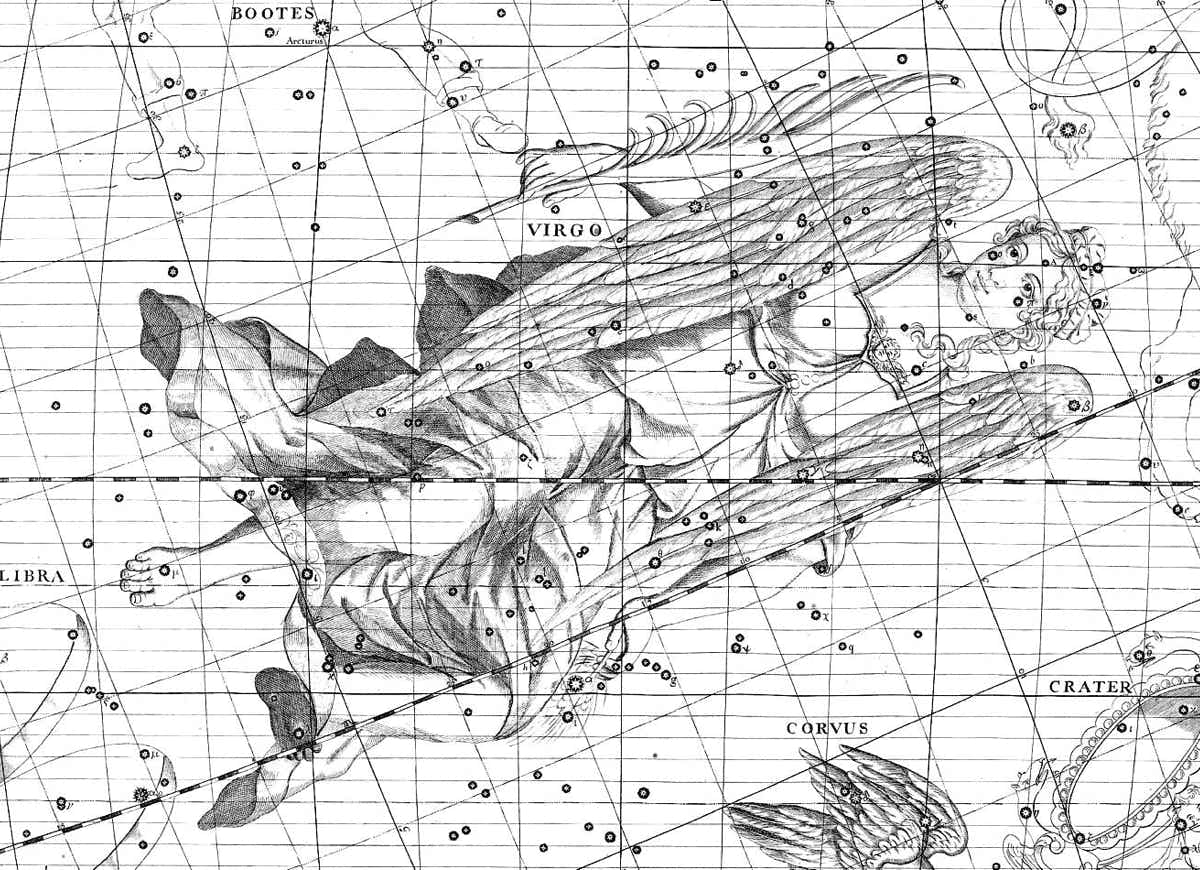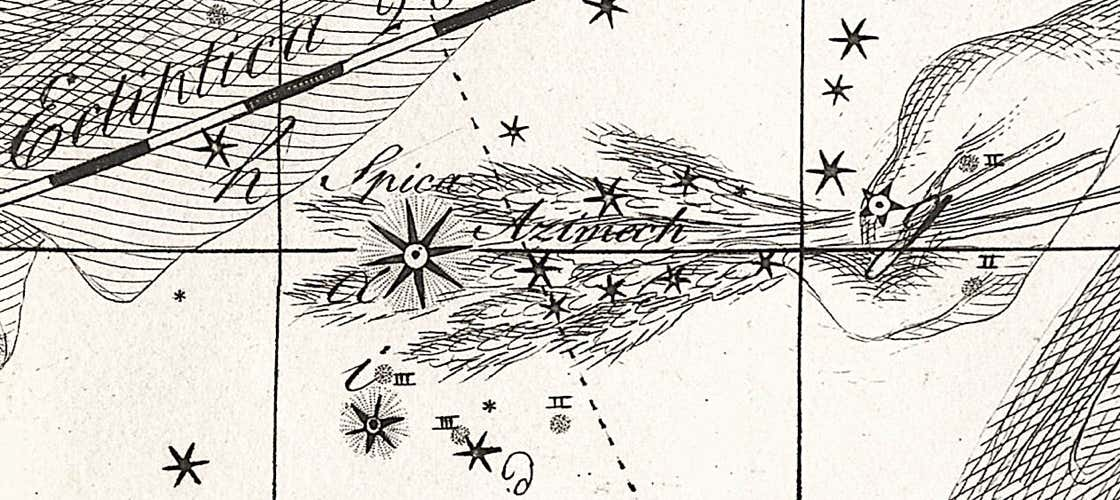
Genitive: Virginis
Abbreviation: Vir
Size ranking: 2nd
Origin: One of the 48 Greek constellations listed by Ptolemy in the Almagest
Greek name: Παρθένος (Parthenos)
Virgo is the second-largest constellation in the sky, exceeded only by the much fainter Hydra. The Greeks called the constellation Παρθένος (Parthenos), which is the name Ptolemy gave in the Almagest. She is usually identified as Dike, goddess of justice, who was daughter of Zeus and Themis; but she is also known as Astraea, daughter of Astraeus (father of the stars) and Eos (goddess of the dawn). Virgo is depicted with wings, reminiscent of an angel, holding an ear of wheat in her left hand (the star Spica).
Dike features as the impartial observer in a moral tale depicting mankind’s declining standards. It was a favourite tale of Greek and Roman mythologists, and its themes still sound familiar today.
Virgo depicted in the Atlas Coelestis of John Flamsteed (1729). In her right hand
she carries a palm frond, while in her left hand she holds an ear of wheat marked
by the bright star Spica.
Dike was supposed to have lived on Earth in the Golden Age of mankind, when Cronus ruled Olympus. It was a time of peace and happiness, a season of perennial spring when food grew without cultivation and humans never grew old. Men lived like the gods, not knowing work, sorrow, crime, or war. Dike moved among them, dispensing wisdom and justice.
Then, when Zeus overthrew his father Cronus on Olympus, the Silver Age began, inferior to the age that had just passed. In the Silver Age, Zeus shortened springtime and introduced the yearly cycle of seasons. Humans in this age became quarrelsome and ceased to honour the gods. Dike longed for the idyllic days gone by. She assembled the human race and spoke sternly to them for forsaking the ideals of their ancestors. ‘Worse is to come’, she warned them. Then she spread her wings and took refuge in the mountains, turning her back on mankind. Finally came the Ages of Bronze and Iron, when humans descended into violence, theft, and war. Unable to endure the sins of humanity any longer, Dike abandoned the Earth and flew up to heaven, where she sits to this day next to the constellation of Libra, which some see as the scales of justice.
Other identifications
There are other goddesses who can claim identity with Virgo. One is Demeter, the corn goddess, who was daughter of Cronus and Rhea. By her brother Zeus she had a daughter, Persephone (also called Kore, meaning ‘maiden’). Persephone might have remained a virgin for ever had not her uncle, Hades, god of the Underworld, kidnapped her while she was out picking flowers one day at Henna in Sicily. Hades swept her aboard his chariot drawn by four black horses and galloped with her into his underground kingdom, where she became his reluctant queen.
Demeter, having scoured the Earth for her missing daughter without success, cursed the fields of Sicily so that the crops failed. In desperation she asked the Great Bear what he had seen, since he never sets, but since the abduction had taken place during the day he referred her to the Sun, who finally told her the truth.
Demeter angrily confronted Zeus, father of Persephone, and demanded that he order his brother Hades to return the girl. Zeus agreed to try; but already it was too late, because Persephone had eaten some pomegranate seeds while in the Underworld and, once having done that, she could never return permanently to the land of the living. A compromise was reached in which Persephone would spend half (some say one-third) of the year in the Underworld with her husband, and the rest of the year above ground with her mother. Clearly, this is an allegory on the changing seasons.
Eratosthenes offers the additional suggestion that Virgo might be Atargatis, the Syrian fertility goddess, who was sometimes depicted holding an ear of corn. But this seems to be a mistake because Atargatis is identified with the constellation Piscis Austrinus. Hyginus, more plausibly, equates Virgo with Erigone, the daughter of Icarius, who hanged herself after the death of her father. In this story, Icarius became the constellation Boötes, which adjoins Virgo to the north, and Icarius’s dog Maera became the star Procyon (see Boötes and Canis Minor).
Eratosthenes and Hyginus both name Tyche, the goddess of fortune, as another identification of Virgo; but Tyche was usually represented holding the horn of plenty (cornucopia) rather than an ear of grain as imagined in the sky.
Spica and the stars of Virgo
The ear of corn held by Virgo in her left hand is represented by the first-magnitude star Alpha Virginis, known as Spica, a Latin name meaning ‘ear of grain’. The star’s name in Greek, Στάχυς (Stachys), has the same meaning. The Arabs knew it both as al-sunbula, meaning ear (from the ear of corn visualized by the Greeks), and also al-Simāk al-a‘zal, the unarmed Simāk. This second name was in contrast to their name for Arcturus, al-Simāk al-rāmiḥ, the Simāk with the lance. According to the Arab star lore expert Danielle Adams of the University of Arizona, Arcturus and Spica were known as the two Sky Raisers (al-simākān), as they seem to support the sky when at their highest. Bode on his atlas labelled the star both as Spica and Azimech, a corruption of al-Simāk.
Beta Virginis is called Zavijava, from the Arabic word zāwiyat meaning ‘angle’; in the Almagest, Ptolemy located this star on the top of Virgo’s left wing. Gamma Virginis, also in the left wing, is called Porrima, after a Roman goddess. According to Ovid in his Fasti, Porrima and her sister Postverta were the sisters or companions of the prophetess Carmenta. Porrima sang of events in the past, while Postverta sang of what was to come.
Epsilon Virginis, on Virgo’s right wing, is named Vindemiatrix, from the Latin meaning ‘grape-gatherer’ or ‘vintager’, because its first visible rising before the Sun in August marked the beginning of each year’s vintage. Ovid in his Fasti tells us that this star commemorates a boy named Ampelus (the Greek word for ‘vine’) who was loved by Dionysus, god of wine. While picking grapes from a vine that trailed up an elm tree, Ampelus fell from a branch and was killed; Dionysus placed him among the stars. This star’s original Greek name, Προτρυγητήρ (Protrygeter), also means ‘grape gatherer’, the same as in Latin. Its importance as a calendar star is demonstrated by the fact that it was one of the few stars named by Aratus and, at third magnitude, was far fainter than the others.
Autumnal equinox
Virgo, incidentally, contains the autumnal equinox, the point at which the Sun crosses the celestial equator heading south; this occurs on September 22 or 23 each year. In ancient times the autumnal equinox lay in Libra, and hence it is still sometimes referred to as ‘the first point of Libra’. However, because of the effect of precession, the autumnal equinox crossed the modern constellation boundary from Libra into Virgo around 730 BC. It continues to move, and will eventually reach Leo in AD 2439.
Chinese associations
In Chinese astronomy, northern Virgo was part of an area called Taiwei, a court or palace of the Emperor, where the Privy Council met in camera for administrative and legal discussions. This court, also known as the Supreme Palace Enclosure, included parts of Coma Berenices and Leo. Taiwei was not in itself a constellation but an area of sky in which events or characters with a common theme were depicted. Being an enclosure it was bounded by walls on the east and west, each marked out by a chain of five stars. The left (eastern) wall started with Eta Virginis and continued northwards via Gamma (Porrima), Delta, and Epsilon Virginis (Vindemiatrix) to Alpha Comae Berenices. The other wall started at Beta Virginis (Zavijava) and ran into Leo, ending at Delta Leonis. Within Taiwei, in the area we now consider the ‘bowl’ of Virgo, various faint stars were seen as representing groups of officials and dignitaries such as Sangong (three stars representing seats for three excellencies), Jiuqing (seats for nine ministers, although it consisted of only three stars) and Yezhe, a court usher, represented by a single star, probably 16 Virginis.
Spica and Zeta Virginis formed Jiao, the horn of the Blue Dragon. Jiao, ‘horn’, was also the first of the 28 Chinese lunar mansions. Since the ecliptic passed between the two stars of Jiao the pair were seen as a gateway for the Sun, Moon, and planets (there are many such gateways in the Chinese sky). Confusingly, two stars to the south of Spica, 53 and 69 Virginis, were also described as a gate, Tianmen, even though they were aligned nearly parallel to the ecliptic and so the Sun could not pass between them.
Two other stars at right angles to the line between Spica and Zeta Virginis, identities uncertain but close to the ecliptic, formed Pingdao, a flat, straight road for the Sun, Moon, and planets. To the right of these a single star, possibly Theta Virginis, was known as Jinxian, representing people of outstanding achievement being recommended for honours or awards. North of Zeta Virginis, two stars (probably Tau and either 78 or Sigma Virginis) were Tiantian, the heavenly fields, in which the Emperor instituted ploughing every spring before the year’s crops were sown.
The stars Lambda, Kappa, Iota, and Phi Virginis formed Kang, the neck of the Blue Dragon, and also the name given to the second lunar mansion. Kang was also visualized in another way more relevant to Chinese society, as a government department administering various home affairs. Near Kang was the similarly named Kangchi, representing a lake with sailing boats. According to Sun and Kistemaker, Kangchi originally consisted of 110, 109, and Mu Virginis, plus three other stars in Libra. Over time, though, it was moved north, first to six stars straddling the border between Virgo and Boötes and finally ending up as four faint stars in Boötes alone.
© Ian Ridpath. All rights reserved




